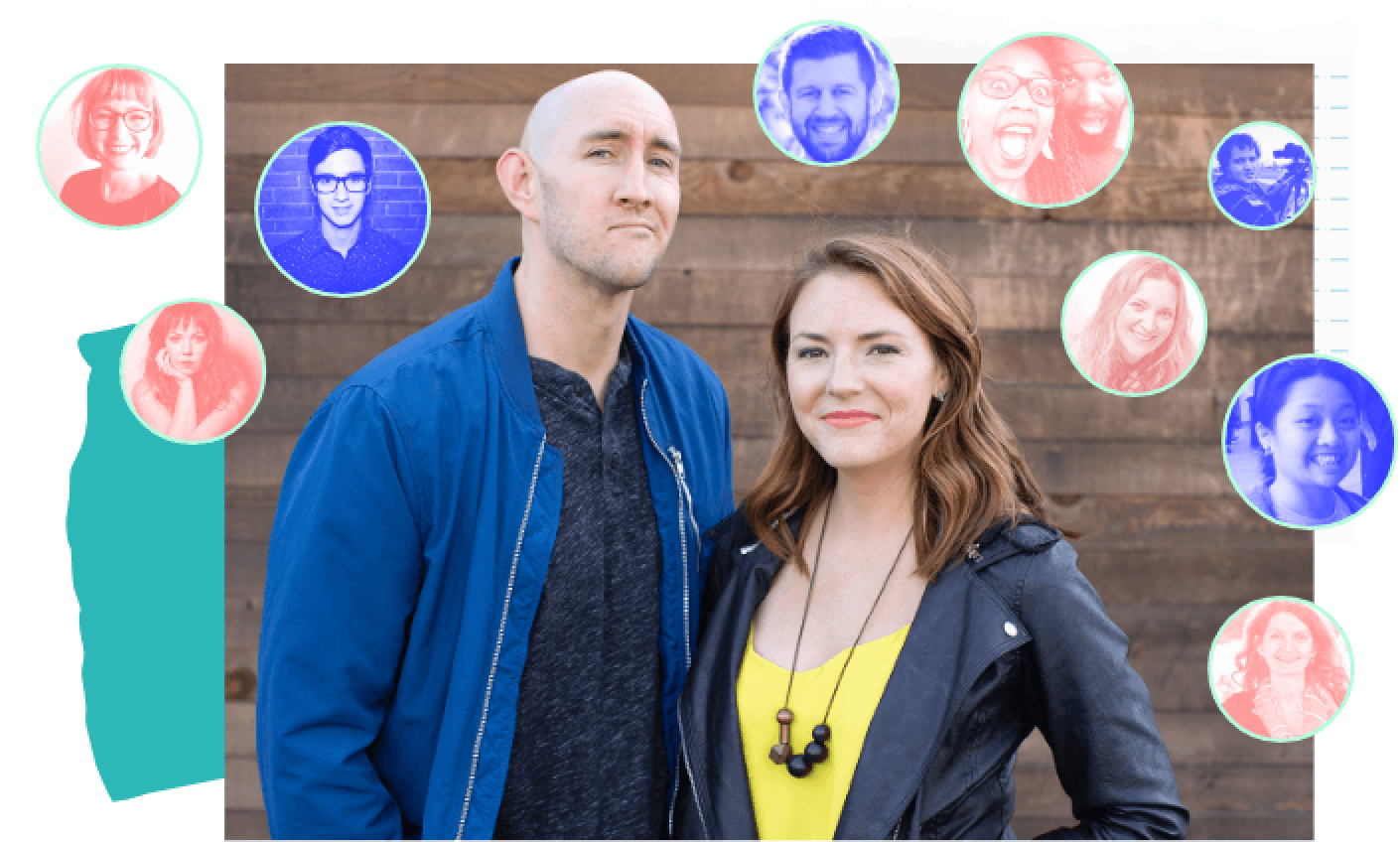Dealing with rejection is a necessary evil to achieving success.
I want you to imagine a number in your mind—a guess about how many times I’ve heard “no” to my ideas. Whether it was trying to convince companies to buy my t-shirt advertising space, place a bid to own my last name, sponsor a page in my first book, or buy one of the 20+ products I’ve released in the past few years.
Do you have your number?
If your number was under 100, you have a lot of faith in me and I love you for that, but oh no, I’m so sorry. You were way off.
If your number was lower than 4,000, you would still be wrong.
I’m sure the actual number of times I’ve been told “no” when asking someone to pay me money for something (since 2008) is higher than 4,000. Here’s how I can say that:
- I wrote at least 1,000 tweets to people to buy spots on the IWearYourShirt calendar
- I sent at least 500 emails in 2009 to companies to sponsor IWearYourShirt
- I wrote over 2,500 emails to people I’d worked with previously (or had talked to previously) to sponsor my book
- I had a spreadsheet of 250 companies I pitched to bid on my last name
- I’ve sent over 50 emails to my various email lists (that range in size from 2,000 – 25,000 people) asking them to buy my products
And boy oh boy, have I racked up the “nos.”
Just Because Someone Says “No” Doesn’t Mean You Should Feel Rejection
People aren’t saying “no” because you’re a bad person.
Early on, I took a “no” to mean I was doing something wrong and that I should feel bad about it. What I started to realize though was not that I was a bad person, it was simply that my ask wasn’t a good fit for the person on the other end for a myriad of reasons.
Sometimes people don’t even have to say the word “no” to you. They simply don’t reply to your ask. They don’t buy your product. They don’t take an action you’d like them to take. Again, even these things don’t mean you’re a bad person.
Here are a few different examples of why people say “no” that have nothing to do with you (or me) as a person:
The timing is wrong
I see this all the time. In fact, I tend to see it every year during the months of June, July, August, and December. Those are the worst months, historically, for me, and the onslaught of “nos.” People are busy with other things. They’re trying to take time off. Or, it’s the end of the year and they can’t be bothered. I do not control the timing and schedules of other people, therefore, I am not a bad person.
It isn’t in the budget
You simply can’t do anything about other people’s budgets. You can’t. If I could, I would invent a magic wand that increases all budgets. I would have waved this wand more than Harry Potter (budgetus increasimus!).
It doesn’t fit with their marketing plan
Well, guess what? You and I didn’t create their marketing plan! Moving on.
They’ve tried this type of thing before and had a bad experience
I don’t get this one as often with my weird ideas, but I do get it with products I sell that have been similar to other products out there. We can’t change a person’s experience with another product. We can give them an opportunity to change their mind by explaining how our product or service is different (and how it specifically solves a problem for them).
They don’t see the value
This is the only example on this list that gets a bit tricky. It’s either a problem with how you and I are explaining our project and the value proposition behind it or the person we’re trying to get a “yes” from just doesn’t get it. I imagine you know I’ve dealt with this a time or two with my weird ideas.
I could go on and on with more examples but the point is…
You need to remove yourself, and the feeling of being personally attacked when someone says “no” to you.
Find gold in your “nos” (not nose) and use rejection to your advantage
This was a little trick I wish I’d stumbled upon way earlier in my time as an entrepreneur. Regardless of where you are in your journey, maybe this trick will help you going forward.
When I was pitching sponsors for my first book project, I had the company Gumroad on my list. (Gumroad is a company that can help you sell digital products.) I thought they’d be the perfect fit for the cover sponsor of my book (a $20,000 ask). Through some Internet sleuthing, I found a guy on Twitter who was doing marketing for Gumroad.
Side note, cool tip thing: In an article I co-wrote with my friend Matt, he found a way to use Google to try to find anyone’s email address at any company. It’s not guaranteed to work, but it’s better than picking your nose. Read the Google hack here.
I sent my pitch email about my $20,000 sponsorship request (ballsy, yes) and was happy to get a quick reply from the guy. Unfortunately, quick replies typically go one of two ways:
1. The person is on-board immediately and you’ve won! You can now swim through your money like Scrooge McDuck.
2. The person says “no” and you have to go back to the drawing board.
The quick response I received was a #2 type of response (and yes, I meant that as a poop euphemism). For some odd reason, I wasn’t ready to accept defeat in that moment. I fired back an email that went something like this:
“Hey ! Thanks for the quick reply. I totally understand this type of sponsorship isn’t a good fit for everyone. That being said, is there any chance you think of anyone off the top of your head that might be a good fit? If you have an email address or have the time to make a super quick intro, I would greatly appreciate it!”
I had no clue if that message would actually get a worthwhile response and any meaningful introductions. But hey, as the not-so-old-adage-you-just-learned goes, you don’t get what you don’t ask for!
I received a reply, and it was exactly what I’d hoped for (not always the case… budgetus increasimus againumys!) The guy had two companies he thought would be interested and he was willing to make a short email intro for me. BOOMSHAKALAKA! (NBA Jam ref, anyone?) Needless to say, I was stoked.
I didn’t know if these email intros would turn into anything, but for the first time in my life, I had taken an “no” email and turned it into a potential “yes.”
That email response lead to two introductions. One of which was the CEO of a company called Treehouse, an online education platform. I’d actually met the CEO, Ryan Carson, at one of Future of Web Apps (FOWA!) conferences many years prior. While the introduction was great, I still had to put in the work to convince Ryan that Treehouse would be a good fit for the $20,000 sponsorship I was asking for. And spoiler alert: Ryan and Treehouse said YES, which you can read more about in the SponsorMyBook story.
You won’t always find gold, but at least you’re trying
Now for some honesty, because that’s how I roll: Landing Treehouse for my book has, to date, still been my biggest victory in turning a “no” into a “yes.” Sure, I’ve had a handful of other victories over the years. However, I’ve had my fair share of additional “nos” as well. And the pile of additional “nos” is exponentially taller than the pile of converted “nos to yeses.” But I just keep trying.
Why?
I want to succeed more than I’m afraid to fail.
I want the dream more than I fear the rejection that comes from making an ask.
I want to succeed more than I’m afraid to fail.
I know from experience that every “no” is another opportunity to hear “yes” later on.
I’m willing to put myself out on the line, because I know that’s what it takes to have incredible things happen in life.
I hope you want those things for whatever it is you’re trying to get. Because if you don’t, then it’s time to figure out what you’re really looking for.
Ready to sniff out some nos of your own?
A challenge for you today: try to get a “no” on one of your ideas. Email a potential sponsor, press send on that podcast interview request, or just ask your local Krispy Kreme to make you some Olympic ring donuts (video below). “Sometimes, when you make a crazy request, you get an awesome answer.”







